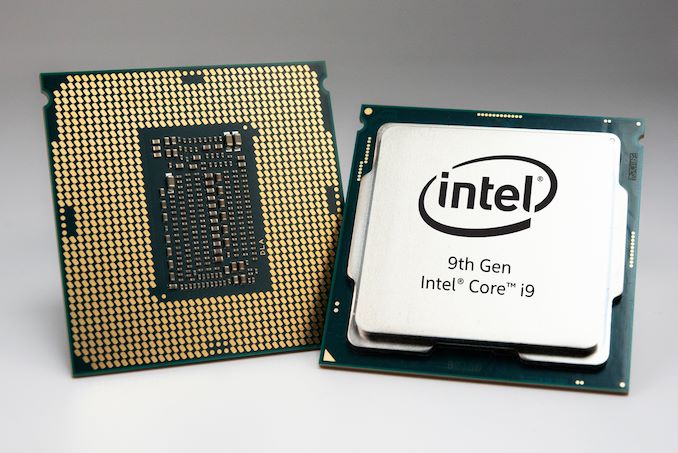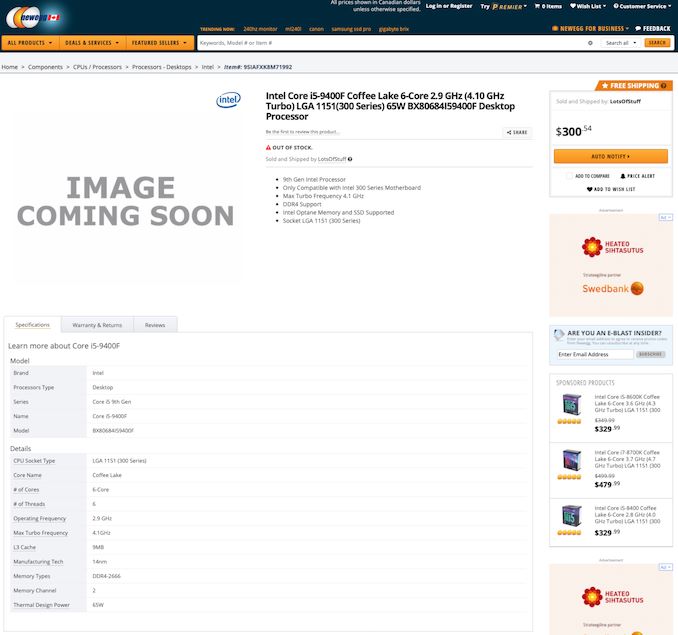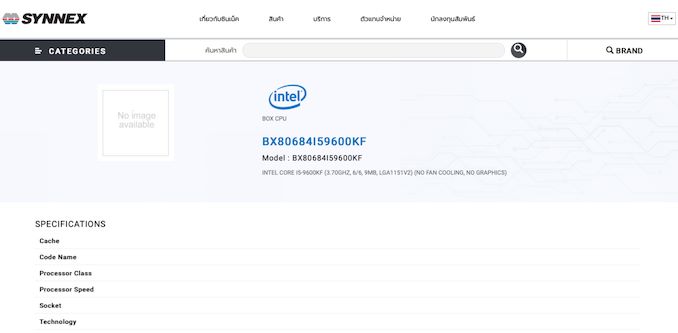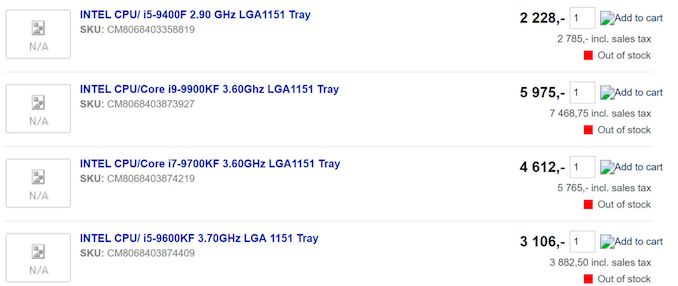Unannounced Intel Core i9-9900KF, i7-9700KF, i5-9600KF and i5-9400F CPUs Listed
by Anton Shilov on December 28, 2018 5:00 PM EST- Posted in
- CPUs
- Intel
- Coffee Lake
- Core 9th Gen

So far Intel's 9th Gen Core on desktop only features three models aimed at the higher end of the spectrum. The launch of the lineup consisting of these three products with unlocked multiplier does not yet have any “locked” parts aimed at mainstream PCs, although we are expecting them at some point. The question is one of when they will come. As it appears, from listings of numerous companies in the supply chain, Intel is finally gearing up to expand its Coffee Lake Refresh family with new models.
The products in question are the eight-core Core i9-9900KF and Core i7-9700KF, as well as the six-core Core i5-9600KF and Core i5-9400F. These devices have been listed by retailers Data-Systems.Fi, Newegg, and distributor Synnex (see screenshots below). According to Intel’s existing nomenclature, the CPUs with model numbers ending with F, like 9400F lack integrated graphics, so we suspect the new processors will primarily target higher-end systems featuring discrete graphics. This will mark the first time that Intel has launched integrated graphics-free processors in its mainstream family at the high-end for many, many years.
The higher-end Core i9-9900KF, Core i7-9700KF, and Core i5-9600KF look set to run at the same frequencies and feature the same cache configurations as their non-F colleagues. As for the Core i5-9400F, this six-core chip runs at 2.9/4.1 GHz, well below the clocks of the i5-9600K, but will have a TDP of 65 W. All of these parts, according to the listings, will be able to be used in current 300-series motherboards.
| Intel's 9th Gen Core Processors for LGA1151 v2 | ||||||||
| AnandTech | Cores | TDP | Freq | L3 | DRAM DDR4 |
iGPU | iGPU Turbo |
|
| Core i9-9900K | $488 | 8 / 16 | 95 W | 3.6 / 5.0 | 16 MB | 2666 | GT2 | 1200 |
| Core i9-9900KF* | ? | - | - | |||||
| Core i7-9700K | $374 | 8 / 8 | 95 W | 3.6 / 4.9 | 12 MB | 2666 | GT2 | 1200 |
| Core i7-9700KF* | ? | - | - | |||||
| Core i5-9600K | $262 | 6 / 6 | 95 W | 3.7 / 4.6 | 9 MB | 2666 | GT2 | 1150 |
| Core i5-9600KF* | ? | - | - | |||||
| Core i5-9400F | ? | 6 / 6 | 65 W | 2.9 / 4.1 | 9 MB | 2666 | - | - |
| *These CPUs has not been launched officially, specifications have not been confirmed. | ||||||||
Intel has not officially confirmed existence of these CPUs, or mentioned plans to release them. In the meantime, listing of the Core i5-9600KF by Newegg and the Core i5-9400F by Synnex Thailand indicates that their launch is likely imminent. Avid readers will remember that CES 2019 is taking place in early January, so the question is whether Intel starts to sell these CPUs more or less quietly ahead of CES, or if it will announce them publicly at the trade show.
In any case, if Intel proceeds with the launch (or rather when), it may broaden availability of its latest eight-core and six-core CPUs both in terms of physical availability and in terms of pricing (i.e., the i9-9900KF will hopefully cost less than the i9-9900K). In the meantime, one has to remember that Intel has high demand issues in general, so the effect of the launch is something that remains to be seen. It could be that the company will not focus on the Pentium/Celeron parts this time around, but instead make these higher-performing (and higher margin) offerings more regular.
Screenshots:
Related Reading:
- The Intel 9th Gen Review: Core i9-9900K, Core i7-9700K and Core i5-9600K Tested
- Analyzing Core i9-9900K Performance with Spectre and Meltdown Hardware Mitigations
- Intel Announces 9th Gen Core CPUs: Core i9-9900K (8-Core), i7-9700K, & i5-9600K
- Intel Coffee Lake Refresh: Global Price Check on 9900K, 9700K, 9600K
Source: Newegg, Synnex, Tom’s Hardware














60 Comments
View All Comments
Santoval - Saturday, December 29, 2018 - link
If it's disabled why would it draw power?shompa - Saturday, December 29, 2018 - link
Remember how Steve Jobs demanded an intel CPU without GPU in 2008? Apple refused for years to move from Core2 CPUs so that their products could have good mainstream GPUs on motherboards. So why hasn't Intel removed iGPU? Its takes 50%-80% of the die area. 1) Remember that the idea was that iGPU would be X86 Larrabee cores. Imagine if this came thru and we could use these cores to power apps in OS?? 2) AMD fanbois do not understand this: The ASP of a PC is 400 dollars. That is GPU. That's why AMD during 2017 just gained 1% market share. 3) Intel does not care about mainstream desktops. They love to charge 10K for CPUs on servers after killing off the competition by subsidizing CPUs. Back in 2006, an MP Xeon cost 300 dollars. Now its 1K at least, (back in 2006 Unix still had over 50% revenue in servers. X86 is not everything that exists. And SPARC/HP/Alpha and so on died because they charged 4500 dollars for a CPU while Xeon did cost 300 dollars. Now Intel abuse this non-competition. If Intel cared about mainstream/high-end "gaming". Imagine a 6-8 core intel without iGPU, but instead having 256meg eDRAM? Intel 5775c is still way faster per clock today with eDRAM than anything else Intel has. But the problem for Intel is this: How to explain that a mainstream eDRAM CPU is faster than their Xeons while Xeons cost 50%-500% more. The best for us all is that MSFT recomplies to ARM so we get real 64bit CPUs. A12 is 40% faster than intel per clock. (so why is ARM slower in some apps? Well. The big perforemce jumps we seen in X86 last 12 years are actually AVX256/512. So of course optimized apps will be faster, just like a Powerbook 667mhz crushed the fastest PC in 2002 AMD 1.5ghz 10 times faster in coding DVD/MPEG2. Apple had Altivec = why insanely faster in media applications. Intel is not good for us. Remember that a 4 core high-end CPU costs under 7 dollar to manufacture. The prices we see today is not normal. Even AMD has over 40% margin (compared to Evil Apple greedy 29% or Good MSFT that have 95% margin in Windows/Office division. Its fun being unbiased like most fanboys)HStewart - Saturday, December 29, 2018 - link
It surprising how much truth you state above. But there is couple of things I am not sure of1. Apple demanding intel to remove iGPU - backing in the older day I remember with iGPU and my desktop lost it GPU - I had to rush to get another one - at least when iGPU came around you had a backup to work things out.
2. I don't remember Lanabee cards at all - I must have miss that time in history - or just didn't care
3. ARM vs x86 - well it depends what application, if recompile for apps and such - it probably does not matter - but real desktop apps don't use basic apps. I would prefer my CS 5 version of Photoshop to subscription versions any day
4. as for Xeon vs desktop CPU's - my understanding of Xeons is compare to desktop CPU, si that tXeon has better IO on system, my Dual Xeon 5150 was faster than any computer sold at BestBuy for many years - only when Skylake come out did I see a big difference. If was not for supid Audio IO on my Supermicro - it could still be used today.
You are absolutely correct Intel does not care about desktops - it is small percentage of computers compare to mobile.
I believe this is a win-win situation for custoimers in long run - Intel iscoming back iand re-investing to make sure there line is competitive - they are being attack by ARM on low end and AMD on high end.
But big question how much power, how many cores does the average customer need. Also how power you need in GPU to run word processors and spreadsheet6s, I and most people on this website are not average customer. My sister leads a manufacturing company that her husband created and has Apple iPad 3 and see no need of upgrading. This is industry biggest problems - current laptop and tablets are good enough for most people. Only hard core gamers need the latest and greatest. I just found out my Sister's husband got a New HP laptop with Mobile Xeon for running SolidWorks and I curious why he didn't - I think possibly they did I t because new Solidworks supports the ABX512.
PeachNCream - Friday, December 28, 2018 - link
As always, the TDP is too high.GreenReaper - Friday, December 28, 2018 - link
You could use it less, I guess? Or pick another CPU. These are high-frequency, high-cache parts. They're going to be expensive, power-wise.If you want lots of lower-powered cores, try an Atom? Don't need so many cores? Celeron or Pentium.
PeachNCream - Saturday, December 29, 2018 - link
That's really the only viable solution these days if you want a decent PC. I'm using a Bay Trail laptop as my primary PC (old HP Stream 11) so the passive cooling and low TDP have totally spoiled me when it comes to getting a good mix of high compute performance and low heat output. The system is not without flaws, but I much prefer using a cooler and quieter system over some hot and loud 95W part in an obsolete desktop form factor. I do keep a couple of other laptops around for heavy lifting. My video production system is a Sandy Bridge 13 inch Dell Latitude which I think has a 35W TDP which is an uncomfortable change from a fully passive Bay Trail even if it is a tad faster and has more RAM.Peter2k - Saturday, December 29, 2018 - link
Wait until you realize that Intel's TDP is at stock clocks without any boost :-)95w is nothing
PeachNCream - Saturday, December 29, 2018 - link
Yeah, that sucks even more about modern Intel chips. The fact that they can hit a peak TDP nearly double the rated 95W is highly disturbing. I need a modern PC to use less power than a standard LED bulb (~9W) under moderate to heavy workloads rather than 20x more energy. Power around here averages 6.6 US cents per kilowatt hour so it adds up quickly when you start demanding 150W at the wall for word processing or fetching e-mail. I can't even imagine gaming on modern PC these days. That's what Android is for...well that and handling phone calls.RSAUser - Monday, December 31, 2018 - link
95W is at stock clocks, if you're just using spreadsheets it will click lower and draw less power.On my machines I use frame caps at around 70 for 60Hz screens, I get draw less power and my fans usually don't turn on.
But those 6c/kWh is not much, full system gaming is about 200-220W for most, so 8 hours for 6c.
us - Monday, December 31, 2018 - link
oops, replied to the wrong comment.have you seen what excel does these days as far as cpu usage? it's a cpu hog now.